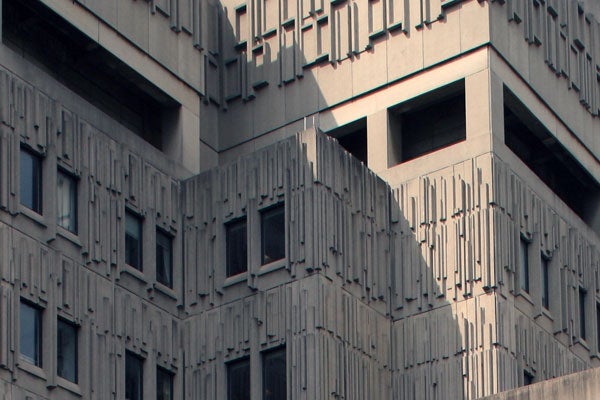
Reducing U of T’s carbon footprint: Medical Science Building retrofit
Published: April 8, 2015
Located in the bowels of the Medical Science Building behind a non-descript door, Artur Syrek’s office is hard to find. The work of Syrek and his team in Utilities & Building Operations – Facilities and Services can easily go unnoticed too, especially by the hundreds of students, faculty and staff who work and study in the building.
But Syrek – who is responsible for operations and maintenance for the MSB and its neighbouring buildings – is quite happy that his work is invisible to the buildings’ inhabitants. It’s a vital job, keeping the 800,000-square-foot building running smoothly, with its complex heating, electrical and ventilation requirements. Housing more than 150 laboratories, it’s the largest medical science building in Ontario – and U of T’s most expensive building to operate.
Before an energy reduction project completed by Facilities and Services in collaboration with the Faculty of Medicine two years ago, U of T was spending more than $6 million and using 271,177 gigajoules of energy each year to run the 46-year-old building. The total project cost was $1.5 million but, thanks to $587,000 in incentives from Toronto Hydro and Enbridge, the net project cost was $913,000.
The results have been dramatic: the project is saving U of T more than $1 million annually in energy costs, as well as hundreds of tonnes of CO2 emissions. Once the third-most energy-intensive building on the St. George campus, it’s now the sixth.
“Each year this project saves us the equivalent energy used by 455 standard Canadian households,” says Ron Swail, U of T’s assistant vice-president of facilities and services. “It’s like taking 1,836 cars off the road.”
The MSB opened in 1969, at a time when energy was cheaper and climate change was not a concern. That made the building an obvious choice to start with, says Swail. “It’s a wet lab building, and wet lab buildings can be anywhere from two to six times more expensive than typical office buildings on a square foot basis. In a wet lab building, the air comes in, it’s heated or cooled, and then it’s exhausted out of the building, for health and safety concerns. Fume hoods are very energy intensive.
 “With MSB we took a very old building with a very old operational design and we put in cutting-edge technology that makes it run like a modern building,” Swail says.
“With MSB we took a very old building with a very old operational design and we put in cutting-edge technology that makes it run like a modern building,” Swail says.
There were three major components to the MSB upgrade: variable speed drives added to the air handling units, a new building automation system, and wireless room level thermostatic control system. The latter can be remotely activated and controlled and data gathered can be studied to try to find ways to save even more energy.
Syrek says he’s still working on ways to reduce the Medical Science Building’s energy footprint.
“The next phase is optimization,” he says. “Only one-third of the building currently has the new wireless thermostats, and we need to complete the installation of those. I’d also like to control our chilled water system with an enthalpy controller [which takes into account humidity as well as temperature]. I don’t think anyone else is doing that.”
U of T shares the benefits of its experience with other institutions, both locally and on a wider scale, Swail says.
“We employ two energy managers who are largely paid for by Toronto Hydro,” Swail says. “Ontario energy managers regularly get together to discuss the projects they are working on, and Toronto Hydro in particular has been a great resource for us on strategies we can employ to reduce energy. They also publish articles on what their customers – including us – are doing to reduce electricity.”
The lessons learned in the MSB retrofit are being applied elsewhere on campus as well. The Ontario Institute for Studies in Education (OISE) building has also been retrofitted, and is saving more than $520,000 and 20,545 gigajoules of energy each year. Robarts Library was recently upgraded, and is already seeing significant results in reduced energy with a current saving estimate of $1.1 million a year. And those are only the most visible projects, Swail says.
“We have completed hundreds of smaller projects over the past decade. At any time, we have at least a dozen projects ongoing and several dozen planned or in design,” he says. “Right now we’re doing lighting retrofits at the Rare Book Library and Rotman; we’re also doing retrofits at the Bahen Centre, the Earth Sciences Building and the Bissell building. We’re constantly looking for ways to lower the St. George campus environmental footprint.”



